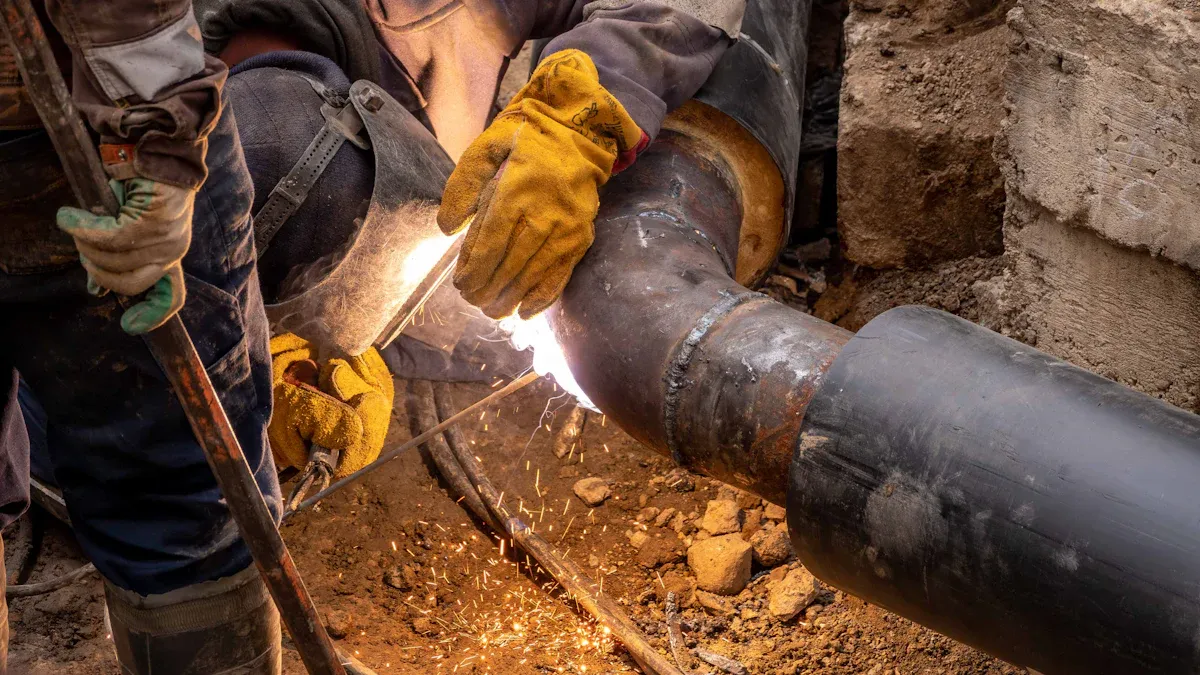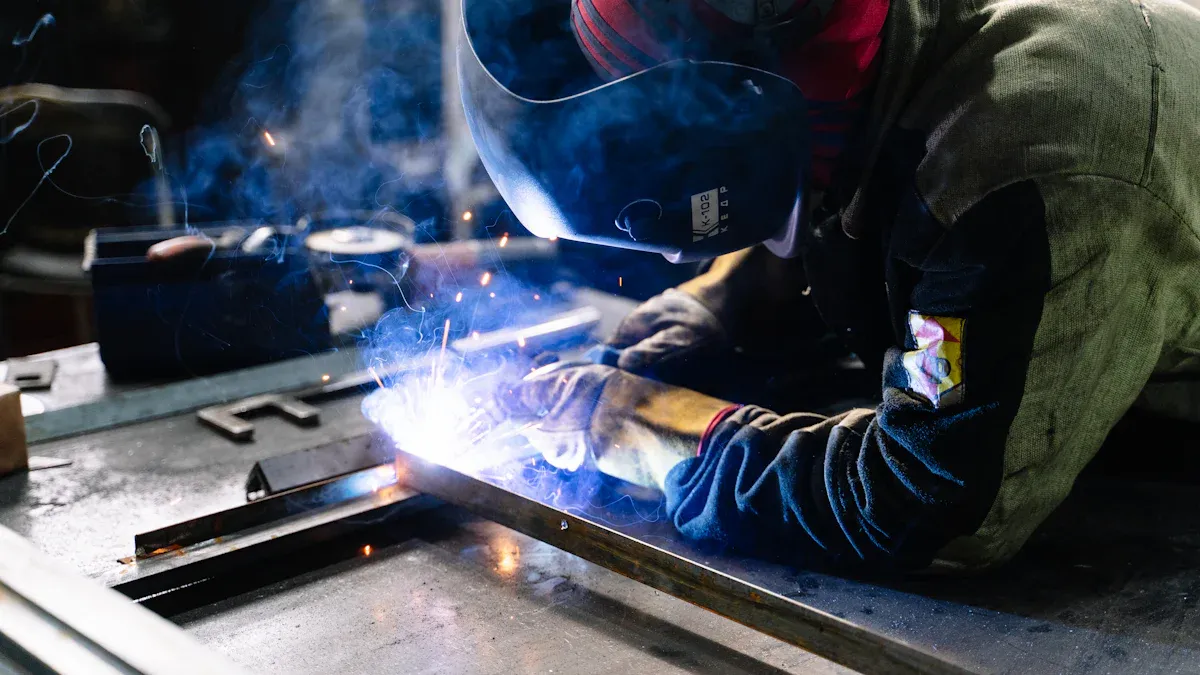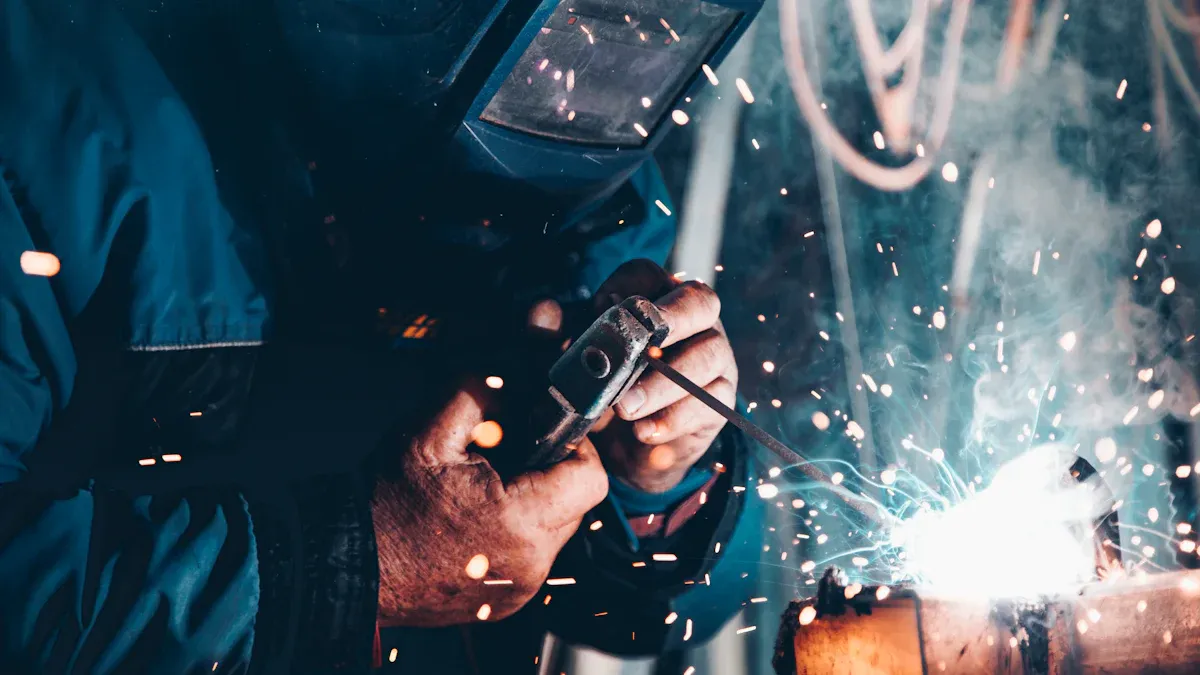Understanding Nickel-Iron Tubing Welding Techniques

Nickel-Iron tubing welding plays a critical role in industries requiring durable and reliable connections. Achieving high-quality welds demands a thorough understanding of proper techniques and attention to detail. Professionals must follow specific welding guidelines to ensure consistent results and avoid defects. Many rely on oem nickel-iron tubing services to access high-grade materials and streamline their processes. Proper execution not only enhances product longevity but also minimizes safety risks during and after welding. Mastery of these skills ensures optimal performance in demanding applications.
Key Takeaways
Preparing joints well makes welds strong. Pick the right design and smooth edges to stop breaks.
Clean tubing surfaces to avoid dirt. Use grinding, chemicals, or tools to make better welds.
Choose the best welding method for the job. GTAW is precise, and GMAW is fast and efficient.
Check heat levels between 200°F and 400°F. This stops cracks and keeps the material strong.
Follow safety rules while welding. Use safety gear, have good airflow, and follow instructions.
Preparation and Cleaning
Joint Preparation for Nickel-Iron Tubing
Proper joint preparation is critical for achieving strong and durable welds in Nickel-Iron tubing. The process begins with selecting the appropriate joint design based on the tubing's thickness and application. Common designs include butt joints, lap joints, and T-joints. Each design ensures optimal weld penetration and strength. Edges of the tubing must be smooth and free from irregularities. Using tools like grinders or files helps achieve precise edge alignment. Misaligned joints can lead to weak welds and structural failures. Professionals often use clamps or fixtures to maintain alignment during welding. This step minimizes movement and ensures consistent results.
Cleaning Methods to Prevent Contamination
Contamination during welding can compromise the integrity of the joint. Cleaning the tubing surface thoroughly is essential. Several methods are effective for removing contaminants:
Surface Preparation: Grinding or sanding removes nickel plating and surface impurities.
Mechanical Cleaning: Abrasive grinding and sandblasting eliminate stubborn contaminants.
Chemical Cleaning: Pickling and pickling paste dissolve oxides and discoloration. These methods require proper safety measures due to the chemicals involved.
Electrochemical Cleaning: This technique uses electric current and electrolyte solutions to clean and passivate the metal surface.
Best Practices: Degreasing the tubing before and after welding, using a TIG brush, and rinsing thoroughly to remove residual chemicals ensure a clean surface.
Each method enhances weld quality by preventing defects caused by impurities.
Avoiding Contamination During Preparation
Maintaining a clean workspace is vital to avoid contamination during preparation. Dust, grease, and moisture can settle on the tubing and affect the weld. Storing Nickel-Iron tubing in a dry, clean environment reduces exposure to contaminants. Wearing clean gloves prevents oils from transferring to the surface. Tools used for preparation should also be free from dirt and debris. Using dedicated tools for Nickel-Iron tubing avoids cross-contamination from other materials. Following these practices ensures a pristine surface, ready for welding.
Welding Techniques

Gas Tungsten Arc Welding (GTAW/TIG) for Nickel-Iron Tubing
Gas tungsten arc welding offers precision and control, making it ideal for Nickel-Iron tubing. This method uses a non-consumable tungsten electrode to create the arc. Operators often prefer GTAW for its ability to produce clean and high-quality welds. The process requires a shielding gas, typically argon or helium, to protect the weld pool from atmospheric contamination.
Professionals use GTAW for applications demanding minimal distortion and superior aesthetics. The technique works well for thin-walled Nickel-Iron tubing, where heat control is critical. Maintaining a steady hand and consistent arc length ensures uniform welds. Operators often rely on fusion welding processes to join the tubing without filler material, enhancing the weld's strength and appearance.
Tip: Using oem nickel-iron tubing services ensures access to high-grade materials that complement the precision of GTAW.
Gas Metal Arc Welding (GMAW/MIG) Applications
Gas metal arc welding provides versatility and efficiency for Nickel-Iron tubing. This method uses a consumable wire electrode fed continuously through a welding gun. The arc melts the wire and tubing, creating a strong joint. Shielding gases like carbon dioxide or argon mixtures protect the weld from oxidation.
GMAW is suitable for thicker Nickel-Iron tubing and high-production environments. Its faster welding speed reduces downtime, making it a popular choice for industrial applications. Operators must adjust voltage and wire feed speed to match the tubing's thickness. Proper settings prevent defects like spatter or incomplete fusion.
Note: GMAW's adaptability makes it a valuable addition to fusion welding processes, especially for large-scale projects.
Shielded Metal Arc Welding (SMAW) Considerations
Shielded metal arc welding remains a reliable option for Nickel-Iron tubing, especially in fieldwork or repair scenarios. This method uses a consumable electrode coated with flux. The flux creates a protective gas shield and slag layer, preventing contamination during welding.
SMAW works well for thicker tubing and applications where portability is essential. Operators must select electrodes compatible with Nickel-Iron alloys to ensure strong welds. Maintaining proper arc length and electrode angle reduces the risk of defects like porosity or cracking.
Alert: Adequate ventilation is crucial when using SMAW due to the fumes generated by the flux coating.
Power Supply and Operational Parameters
The power supply and operational parameters play a crucial role in achieving high-quality welds in Nickel-Iron tubing. Proper settings ensure consistent arc stability, optimal penetration, and reduced defects. Operators must select parameters based on electrode diameter, tubing thickness, and welding method.
Recommended Settings for Nickel-Iron Tubing Welding
The table below outlines the recommended current and voltage settings for various electrode diameters:
Electrode Diameter | Current (A) | Voltage (V) |
|---|---|---|
3/32 | 2.4 | 22-24 |
1/8 | 3.2 | 22-24 |
5/32 | 4.0 | 22-25 |
3/16 | 4.8 | 24-26 |
Operators should adjust these parameters to match the tubing's material properties and joint design. Incorrect settings can lead to issues such as incomplete fusion or excessive spatter.
Visualizing Current Values
The chart below illustrates the current values for Nickel-Iron welding electrodes, providing a clear comparison across different diameters:
Maintaining consistent power supply settings ensures uniform heat distribution and weld quality. Operators often rely on advanced welding machines with programmable features to achieve precision. These machines allow for real-time adjustments, enhancing control during the welding process.
Tip: Using oem nickel-iron tubing services ensures access to high-grade materials that complement the precision required for optimal power supply settings.
Shielding Gases and Their Role in Welding Nickel-Iron Tubing
Shielding gases protect the weld pool from atmospheric contamination, ensuring stability and quality during Nickel-Iron tubing welding. The choice of shielding gas significantly impacts heat concentration, microstructure, and mechanical properties of the weld.
Effects of Shielding Gas Composition
The table below highlights key findings related to shielding gas composition and its influence on weld characteristics:
Aspect | Findings |
|---|---|
Heat Concentration | Variations in shielding gas compositions affect heat concentration, impacting weld quality. |
Microstructure | Different gases lead to variations in grain size and phase transformations during welding. |
Mechanical Properties | W1 exhibited higher elongation and strength due to fine microstructure compared to W2 and W3. |
Phase Transformations | W3 showed needle martensite formation due to high cooling rates, affecting weld stability. |
Joint Characteristics | The composition of shielding gas influences joint geometrical properties and overall weld integrity. |
Cooling Rate | Higher CO2 levels (>20%) reduce arc heat efficiency, affecting cooling rates and weld quality. |
Selecting the Right Shielding Gas
Argon and helium are commonly used shielding gases for Nickel-Iron tubing. Argon provides excellent arc stability and is ideal for precision welding. Helium enhances heat transfer, making it suitable for thicker tubing. Mixtures of argon and carbon dioxide balance cost-effectiveness and weld quality.
Operators must consider the tubing's thickness, joint design, and desired mechanical properties when selecting shielding gases. For applications requiring submerged arc welding, shielding gas composition becomes even more critical to ensure weld integrity.
Alert: Higher CO2 levels can reduce arc heat efficiency, leading to slower cooling rates and potential weld defects.
Temperature and Safety Considerations

Managing Interpass Temperatures
Controlling interpass temperatures is essential for maintaining weld quality in Nickel-Iron tubing. Excessive heat can lead to material degradation, while insufficient heat may cause incomplete fusion. Operators should monitor interpass temperatures using infrared thermometers or contact pyrometers. Maintaining a consistent temperature range prevents thermal stress and cracking. For Nickel-Iron tubing, interpass temperatures typically range between 200°F and 400°F, depending on the material's thickness and application.
Preheating the tubing before welding can also help manage interpass temperatures. This step reduces the risk of rapid cooling, which may lead to brittle welds. Post-weld heat treatment (PWHT) further enhances the weld's mechanical properties by relieving residual stresses. Following these practices ensures a durable and defect-free weld.
Ventilation and Safety Standards
Proper ventilation is critical for ensuring a safe and contamination-free welding environment. Welding fumes contain hazardous substances that can harm workers if inhaled. Adhering to safety standards like ANSI Z49.1 and OSHA's Hazard Communication standard minimizes these risks. Key recommendations include:
Training: Management must train welders in safe operation and emergency procedures.
Hazard Communication: Employers should evaluate and communicate chemical hazards effectively.
Precautionary Measures: Workers must understand hazards and safety precautions before starting work.
Mechanical ventilation becomes necessary when natural airflow is insufficient. For confined spaces, ventilation systems should provide at least 2,000 cubic feet of air per minute per welder. Respiratory equipment should be used if ventilation fails to reduce contaminants to acceptable levels. These measures protect welders and maintain a safe workspace.
Best Practices for Safe Welding
Adopting best practices ensures safety and efficiency during Nickel-Iron tubing welding. Operators should follow documented procedures like Welding Procedure Specifications (WPS) and Procedure Qualification Records (PQR) to comply with industry standards. The table below highlights key practices:
Best Practice/Technique | Description |
|---|---|
Gas Flow Rates | Maintain 15-20 CFH for GTAW to prevent porosity. |
Tack Welds | Use at 50-75 mm intervals to minimize warpage. |
Material Certifications | Verify MTRs for compliance with ASTM B366. |
Ventilation | Use LEV systems to manage harmful fumes. |
PPE | Wear respirators and heat-resistant gloves during welding. |
Using oem nickel-iron tubing services ensures access to high-grade materials that meet these standards. These services streamline the process and enhance weld quality. By combining proper techniques with safety measures, operators can achieve optimal results while minimizing risks.
Common Challenges and Solutions
Addressing Ductility and Weld Strength
Ductility and weld strength are critical factors in Nickel-Iron tubing welding. Low ductility can lead to brittle welds, while insufficient strength compromises the joint's durability. Operators must select filler materials compatible with Nickel-Iron alloys to enhance ductility. Preheating the tubing before welding reduces thermal stress and improves material pliability. Post-weld heat treatment (PWHT) further strengthens the weld by relieving residual stresses and refining the microstructure.
Joint design also plays a significant role in weld strength. Butt joints provide uniform stress distribution, while lap joints offer increased surface area for bonding. Proper alignment and edge preparation ensure optimal load-bearing capacity. Welding techniques like Gas Tungsten Arc Welding (GTAW) allow precise control over heat input, minimizing distortion and enhancing ductility.
Tip: Using oem nickel-iron tubing services ensures access to high-grade materials that support ductility and weld strength, reducing the risk of failure in demanding applications.
Preventing Cracking and Material Degradation
Cracking and material degradation are common challenges in Nickel-Iron tubing welding. These issues often arise due to improper heat control, contamination, or residual stresses. Operators must monitor interpass temperatures to prevent thermal stress. Maintaining a consistent temperature range between 200°F and 400°F minimizes the risk of cracking.
Contamination during welding can accelerate material degradation. Cleaning the tubing surface thoroughly and using shielding gases like argon protect the weld pool from atmospheric impurities. Selecting electrodes compatible with Nickel-Iron alloys reduces susceptibility to corrosion cracking.
Technical studies provide valuable insights into preventing these issues. The table below summarizes key findings:
Study Title | Key Findings |
|---|---|
Highlights the impact of joint configuration and welding conditions on weld integrity, particularly susceptibility to corrosion cracking. | |
Fracture Assessments of Welded Structures | Discusses the susceptibility of weldments to fracture due to defects and stresses, emphasizing the need for realistic modeling in assessments. |
Compatibility of Fracture Mechanics Parameters | Analyzes the effects of variable loads on welded joints, focusing on fatigue crack growth parameters and their implications for safety. |
Operators can apply these findings by optimizing joint design, welding parameters, and post-weld treatments. These measures ensure long-term durability and resistance to degradation.
Ensuring High-Quality Welds
Achieving high-quality welds requires attention to detail and adherence to best practices. Operators must follow documented procedures like Welding Procedure Specifications (WPS) to ensure consistency. Proper shielding gas selection enhances weld stability and appearance. Argon provides excellent arc control, while helium improves heat transfer for thicker tubing.
Tack welds at regular intervals prevent warpage and maintain alignment during welding. Maintaining gas flow rates between 15-20 CFH for GTAW prevents porosity. Visual inspections and non-destructive testing (NDT) methods like ultrasonic testing verify weld integrity.
Alert: Welders should wear appropriate personal protective equipment (PPE) and ensure proper ventilation to maintain safety during high-quality welding processes.
Combining these practices with high-grade materials from oem nickel-iron tubing services ensures optimal results. Operators can achieve durable, defect-free welds that meet industry standards.
Preparation, technique selection, temperature control, and safety are essential for successful Nickel-Iron tubing welding. Each step contributes to weld quality and durability. Proper cleaning and joint preparation eliminate impurities, while selecting the right welding method ensures precision. Monitoring interpass temperatures and adhering to safety standards protect both the weld and the operator.
Following welding guidelines guarantees optimal results. Professionals who use oem nickel-iron tubing services gain access to high-grade materials that simplify the process and enhance weld integrity. By adopting best practices, operators can achieve reliable, defect-free welds while prioritizing safety.
FAQ
What are the most common welding methods for Nickel-Iron tubing?
The most common methods include Gas Tungsten Arc Welding (GTAW/TIG), Gas Metal Arc Welding (GMAW/MIG), and Shielded Metal Arc Welding (SMAW). Each method suits specific applications based on tubing thickness, joint design, and production requirements.
Why is shielding gas important in Nickel-Iron welding?
Shielding gas protects the weld pool from atmospheric contamination. It ensures weld stability, prevents oxidation, and enhances mechanical properties. Argon, helium, or their mixtures are commonly used for Nickel-Iron tubing welding.
How can welders prevent cracking in Nickel-Iron tubing?
Welders can prevent cracking by controlling interpass temperatures, preheating the tubing, and using compatible filler materials. Thorough cleaning and proper shielding gas selection also reduce contamination, which minimizes the risk of cracking.
What safety measures should welders follow during Nickel-Iron welding?
Welders should ensure proper ventilation, wear personal protective equipment (PPE), and follow documented procedures like Welding Procedure Specifications (WPS). Adhering to safety standards like ANSI Z49.1 and OSHA guidelines minimizes risks.
How does preheating improve weld quality?
Preheating reduces thermal stress and prevents rapid cooling, which can lead to brittle welds. It also enhances ductility and ensures better fusion between the tubing and filler material, resulting in stronger joints.
Tip: Use an infrared thermometer to monitor preheating temperatures for consistent results.
See Also
Latest Developments in Nickel-Titanium Laser Cutting Techniques
Strategies for Addressing Nickel-Titanium Alloy Laser Micromachining Issues
The Influence of Cyclic Life Testing on NiTi Tubing Durability
Evaluating Nitinol Tubing's Tensile Strength Against Stainless Steel
Comprehensive Guide for Selecting Appropriate Nitinol Tubing

